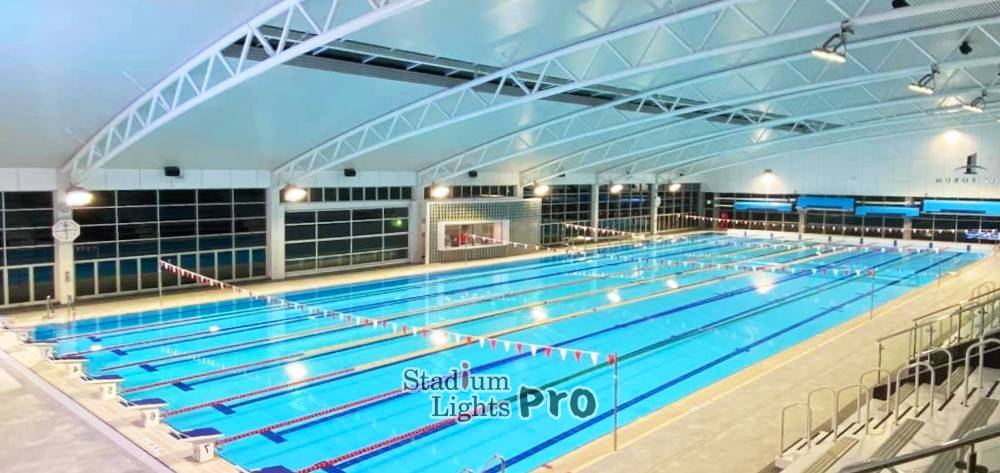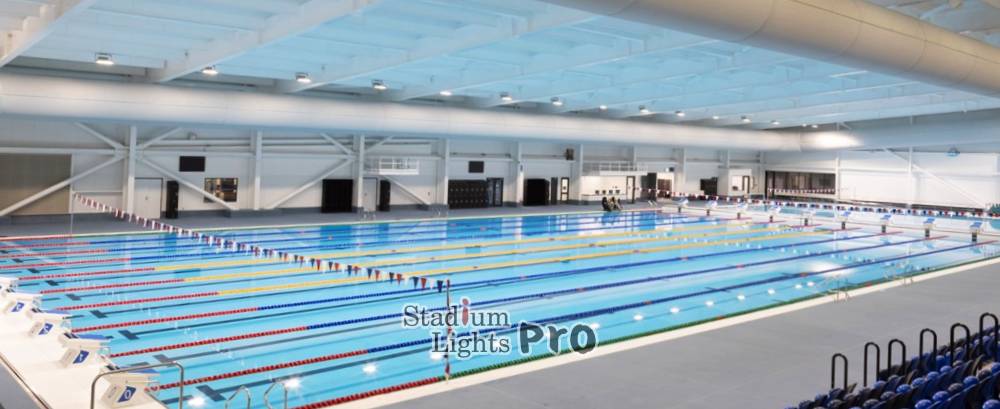Natatoriums, or indoor swimming pools, are specialized environments that require carefully considered lighting solutions to ensure both functionality and safety. The unique setting of a natatorium, characterized by high levels of humidity and the presence of chlorinated water, presents specific challenges for lighting systems. Proper lighting is crucial not only for providing adequate visibility for swimmers and lifeguards but also for enhancing the overall ambiance and aesthetic appeal of the facility. Selecting the appropriate lighting for these environments is essential to withstand the high humidity and corrosive effects, ensuring longevity and reducing maintenance costs. Therefore, understanding the specific needs of natatorium lighting and choosing fixtures that can endure such harsh conditions is paramount for creating a safe and pleasant aquatic environment.
Table of Contents
ToggleUnderstanding High Humidity Environments
Definition and Characteristics of High Humidity Environments
High humidity environments are characterized by a significant amount of moisture in the air, typically defined by relative humidity levels above 60%. In these settings, water vapor is abundant, leading to a damp and often muggy atmosphere. Natatoriums, due to their large water surfaces and heated pools, inherently maintain high humidity levels. This constant presence of moisture in the air can lead to condensation on various surfaces, creating a unique and challenging environment for any electrical and mechanical systems within the space.
Specific Challenges Posed by High Humidity in Natatoriums
The high humidity in natatoriums presents several specific challenges, particularly for lighting systems. The continuous exposure to moisture can lead to corrosion of metal components, reducing the lifespan and reliability of lighting fixtures. Furthermore, condensation can infiltrate lighting enclosures, causing electrical malfunctions or short circuits. This environment also fosters the growth of mold and mildew, which can compromise the structural integrity and hygiene of the lighting installations. Additionally, the combination of humidity and chlorinated water can produce a highly corrosive atmosphere, exacerbating the wear and tear on lighting fixtures and necessitating the use of specially designed, durable lighting solutions. Therefore, addressing these challenges is crucial for ensuring safe, effective, and long-lasting lighting in natatoriums.
Importance of Suitable Lighting
Impact of Humidity on Lighting Fixtures and Performance
High humidity can significantly impact the performance and longevity of lighting fixtures in natatoriums. Moisture can penetrate lighting enclosures, leading to electrical malfunctions, short circuits, and even potential fire hazards. Corrosion is another major issue, as metal components within the fixtures can rust and degrade over time, resulting in reduced structural integrity and eventual failure. The constant exposure to a humid environment can also cause discoloration of lenses and reflective surfaces, diminishing the quality and effectiveness of the light output. This degradation not only affects the functionality of the lights but can also increase maintenance costs and frequency of replacements.
Safety and Durability Considerations for Natatorium Lighting
Ensuring safety and durability in natatorium lighting is paramount. Lighting fixtures must be designed to withstand high humidity levels, often requiring waterproof and moisture-resistant properties. IP (Ingress Protection) ratings are crucial indicators of a fixture’s ability to resist water and dust, with higher ratings being more suitable for natatorium environments. Additionally, materials used in the construction of these fixtures should be corrosion-resistant, such as stainless steel or specially coated metals, to prevent rust and deterioration.
Proper sealing and gasketed enclosures are essential to prevent moisture ingress and protect the electrical components inside. Safety considerations also extend to ensuring adequate illumination to avoid shadows and dark spots that could pose risks for swimmers and lifeguards. Fixtures should provide even, glare-free lighting to enhance visibility and create a safe environment.
Durability in lighting not only ensures long-term performance but also reduces maintenance efforts and costs. Choosing high-quality, durable fixtures designed for high humidity environments helps maintain consistent lighting conditions, contributing to the overall safety and aesthetic quality of the natatorium.

Types of Natatorium Lights Suitable for High Humidity
LED lights are an excellent choice for natatoriums due to their energy efficiency, long lifespan, and robust performance. In high humidity environments, it is crucial to select LED fixtures specifically designed to be waterproof and corrosion-resistant. These lights typically feature sealed housings and protective coatings that prevent moisture penetration and withstand the corrosive effects of chlorine and other chemicals commonly found in pool environments. The advanced design of these fixtures ensures consistent light output and minimal maintenance requirements, making them ideal for natatorium applications.
The Ingress Protection (IP) rating system is a crucial standard for assessing the suitability of lighting fixtures for high humidity environments. IP ratings indicate the degree of protection a fixture offers against the intrusion of solids and liquids. The rating is typically represented by two digits, with the first digit indicating protection against solids (such as dust) and the second digit indicating protection against liquids (such as water). For example, an IP65 rating means the fixture is dust tight and protected against water jets.
For natatorium environments, where high humidity and exposure to splashing or spraying water are common, it is recommended to use fixtures with an IP rating of at least IP65. This rating ensures that the fixtures are dust tight and protected against water jets, providing a high level of resilience to the conditions present in indoor aquatic centers.
Enclosed and gasketed fixtures are designed to provide additional protection against moisture and contaminants. These fixtures feature sealed housings and gaskets that create a tight barrier, preventing the ingress of water and dust. This design is particularly beneficial in high humidity environments, as it enhances the durability and reliability of the lighting systems. Enclosed and gasketed fixtures are ideal for use in areas directly exposed to water splashes and high levels of moisture.
To further enhance the durability of natatorium lights, using fixtures made from anti-corrosive materials and coatings is essential. Stainless steel, anodized aluminum, and specially coated metals are commonly used to resist corrosion and rust in humid and chemically aggressive environments. These materials, combined with advanced coatings, provide a robust defense against the corrosive effects of chlorine, salt, and other pool chemicals. Choosing fixtures with anti-corrosive properties ensures a longer lifespan and reduced maintenance efforts, maintaining optimal lighting conditions in the natatorium.
Features to Look for in High Humidity Natatorium Lights
Waterproof and moisture-resistant properties are essential to prevent damage from the constant exposure to water and humidity. Additionally, corrosion-resistant materials are crucial, as the humid and often chlorinated atmosphere can quickly degrade standard materials. Effective heat dissipation mechanisms are also vital to maintain optimal light performance and longevity. Furthermore, energy efficiency and a long lifespan contribute to reduced operational costs and environmental impact. Finally, it’s imperative to ensure that the lighting fixtures have proper certification and compliance with industry standards, guaranteeing their suitability and safety for use in natatorium settings.

Popular Brands and Models
When it comes to high humidity-resistant natatorium lights, several leading brands stand out for their innovative designs and reliable performance. Brands such as Lithonia Lighting, Cree, GE Lighting, and Philips have established themselves as industry leaders by offering products specifically designed to withstand the challenging conditions of natatorium environments.
Lithonia Lighting offers models like the Lithonia WLF LED, which is renowned for its waterproof design and energy efficiency. Its durable construction and long lifespan make it a popular choice for natatoriums.
Cree provides the Cree IG Series, known for its excellent heat dissipation and corrosion-resistant materials. This model also boasts high energy efficiency and compliance with rigorous industry standards, ensuring both performance and safety.
GE Lighting features the GE Evolve LED Series, which excels in high humidity environments due to its robust waterproofing and advanced heat management system. This series is also praised for its long lifespan and reduced maintenance requirements.
Philips presents the Philips Chloride Class 2, a model specifically designed for natatorium use with superior moisture and corrosion resistance. Its energy-efficient design and comprehensive industry certifications make it a top choice for many facilities.
Comparative analysis of these models reveals that while all offer robust waterproofing and resistance to corrosion, differences lie in their energy efficiency, heat dissipation mechanisms, and lifespan. For instance, the Cree IG Series may offer better heat dissipation compared to others, while the Philips Chloride Class 2 might excel in overall energy efficiency. Selecting the right model depends on the specific requirements of the natatorium, such as the size of the facility, budget constraints, and maintenance capabilities.
Installation and Maintenance Tips
Proper installation and maintenance are crucial to maximizing the durability, longevity, and performance of high humidity natatorium lights. When installing these lights, it is important to choose the right location, ensuring they are placed where they are least exposed to direct water spray or steam. Strategic placement significantly reduces wear and tear on the fixtures. Additionally, securing the lights with corrosion-resistant mounting hardware prevents instability caused by humidity or vibrations within the facility.
Using waterproof sealants and high-quality gaskets is essential to prevent moisture ingress, maintaining the integrity of the fixtures over time. Adhering meticulously to the manufacturer’s installation guidelines ensures the lights are installed correctly and safely, optimizing their designed features for high humidity environments. Proper wiring, with waterproof connectors and well-insulated wires, reduces the risk of electrical faults and enhances safety. It is also crucial to consider heat management by installing fixtures to allow adequate ventilation, aiding effective heat dissipation and extending the lifespan of the lights.
Regular maintenance practices are equally important for ensuring the longevity and performance of natatorium lights. Routine inspections should be conducted to check for signs of wear, corrosion, or water damage, as early detection of issues can prevent major failures and extend the life of the fixtures. Keeping the light fixtures clean from dust, grime, and mineral deposits with non-abrasive, moisture-resistant cleaning agents helps avoid damage. Periodically checking and replacing seals and gaskets ensures they are intact and functioning properly, as damaged seals can lead to moisture ingress and compromise the fixture’s performance.
Monitoring the performance of the lights is also vital. Flickering or dimming lights could indicate underlying issues that need immediate attention. Damaged or worn-out components should be promptly replaced with parts that meet the original specifications to maintain the integrity of the entire lighting system. Regular professional maintenance checks are recommended, as experts can provide thorough inspections and address issues that might not be visible during routine checks.
By adhering to these installation and maintenance practices, you can ensure that your high humidity natatorium lights remain durable, safe, and efficient, providing reliable performance for years to come.
Case Studies
Real-World Examples of Successful Natatorium Lighting Installations in High Humidity Environments
Community Aquatic Center in Seattle, Washington
The Community Aquatic Center in Seattle faced significant challenges with its outdated lighting system, which frequently malfunctioned due to high humidity and chlorine exposure. To address this, the center underwent a major renovation, opting for Lithonia WLF LED fixtures known for their waterproof design and energy efficiency. These lights were strategically placed to minimize direct exposure to water and steam. The new installation greatly improved lighting quality and reduced maintenance costs. Key lessons from this project include the importance of strategic light placement to avoid direct exposure to water, the use of high-quality waterproof sealants and gaskets, and the selection of energy-efficient models to reduce operational costs.
Olympic Training Facility in Colorado Springs
The Olympic Training Facility in Colorado Springs required a robust lighting solution that could withstand intense humidity and high chlorine levels. The facility chose Cree IG Series lights for their excellent heat dissipation and corrosion-resistant materials. Advanced waterproofing techniques, including the use of high-grade sealants and gaskets, were employed during installation. This not only improved the lighting conditions but also enhanced the athletes’ training experience by providing consistent and high-quality illumination. Lessons learned from this installation emphasize the importance of top-tier waterproofing methods, effective heat dissipation mechanisms, and the use of corrosion-resistant materials to prevent degradation in high humidity environments.
University Natatorium in Florida
Situated in a region with naturally high humidity, the University Natatorium in Florida needed a reliable lighting system. The facility selected GE Evolve LED Series fixtures for their robust waterproofing and advanced heat management system. The installation team meticulously followed the manufacturer’s guidelines, ensuring proper wiring and secure mounting with corrosion-resistant hardware. This upgrade resulted in enhanced visibility and reduced energy consumption, contributing to a better environment for both athletes and spectators. From this project, key takeaways include the criticality of following manufacturer guidelines meticulously, ensuring waterproof connections and well-insulated wires, and the necessity of routine maintenance practices such as regular inspections and cleaning to maintain system efficiency and longevity.
These case studies collectively highlight the importance of careful planning and execution in natatorium lighting installations. Essential lessons include the strategic placement of lights to avoid direct water exposure, the use of high-quality waterproofing materials, effective heat management, adherence to manufacturer installation guidelines, proper wiring techniques, and regular maintenance practices. By adopting these best practices, facilities can ensure their lighting solutions remain durable, efficient, and effective in high humidity environments.
Conclusion
During installation, secure mounting, waterproof sealants, and careful placement help prevent damage. Regular maintenance, including inspections, cleaning, and timely repairs, extends lighting lifespan and efficiency. Case studies from facilities like the Community Aquatic Center and the Olympic Training Facility show how these practices improve lighting quality and reduce costs. In summary, selecting durable fixtures, following strict installation protocols, and maintaining them regularly ensures optimal performance in natatoriums.

